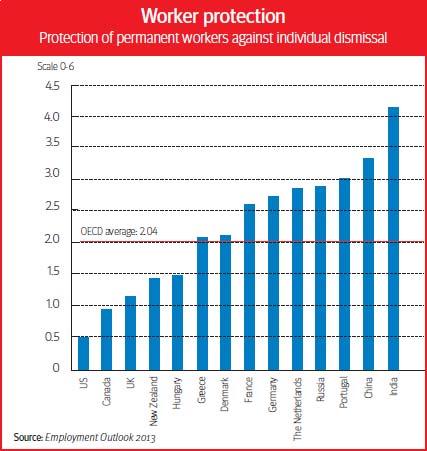In the developed world protection of permanent workers against individual dismissal is generally very high in Europe. However some emerging countries have better protection for workers than in Europe as shown in the chart below:
Click to enlarge
Source: Containting costly job losses, OECD Observer
According to OECD, India has the highest protect for permanent workers while the U.S. has the lowest. In fact, India labor laws for permanent workers is stricter than China’s.
From an article in Knowledge@Wharton from Wharton School of the University of Pennsylvania:
India’s labor laws — largely unchanged from how the British wrote them — have a negative view of private sector employers. This view believes that all employers are exploiters; that most employees have no alternative employment options; that most employers are big companies, and that shareholders pay salaries not customers. This has led to four painful defects in India’s labor market: 12% manufacturing employment (the same as the post-industrial U.S.), 50% agricultural employment (240 million Indian produce less food than four million Americans), 50% self-employment (the poor cannot afford to be unemployed, so they are subsistence self-employed), and 90% informal employment (100% of net job creation since 1991 has happened informally.)
India’s labor laws are a mess. It is practically impossible to comply with 100% of them without violating 10% of them. Most employment contracts are marriages without divorce; on paper you can’t get rid of an employee once you have hired him or her. (emphasis added)
Source: Why the New Labor Law Reforms Make India Fertile for Jobs, Knowledge@Wharton
I is interesting that Russia ranks higher than even France in worker protection. However it must be noted that Russia until a few decades ago was a communist country and laws were created that favored workers. Even today the majority of the workforce in Russia work in the public sector and the state is the largest employer.
It should be noted that since hiring and firing of both temporary and permanent workers is easy in the U.S., the American economy is the most vibrant economy in the world. American employers hire workers when demand picks up for their products or services and fire or lay them off during periods of slack demand. This is not possible in most of the countries shown in the above chart. Hence workers stay on a company’s payroll sometimes for years as it is difficult for employers to get rid of them.
Related: Factbox: India’s stringent labor laws, Reuters




